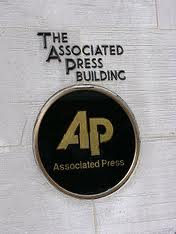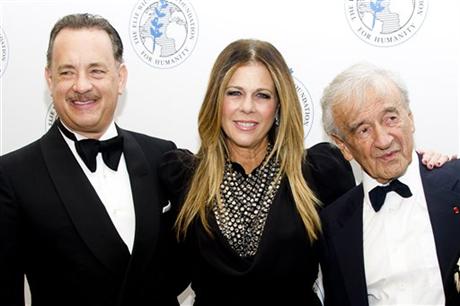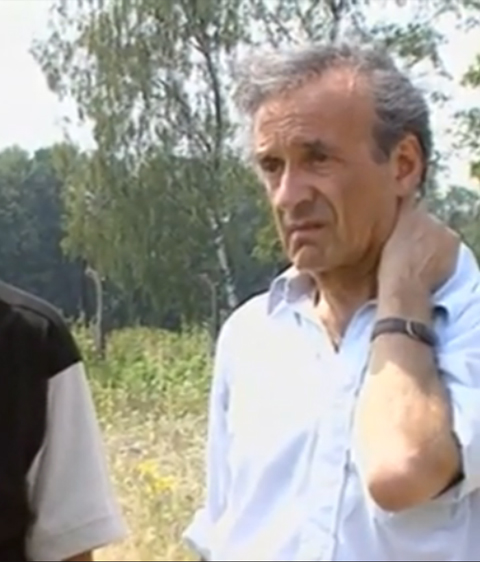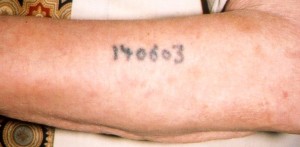Tuesday, December 4th, 2012
 by Carolyn Yeager
by Carolyn Yeager
My latest phone call on the morning of Monday Dec. 3 to the Associated Press office in New York brought the following results: The answerer, upon hearing my name, immediately connected me to Corporate Communications, where I spoke to the same woman I spoke with the previous Monday, Nov. 26. I identified myself and told her I had re-sent the first email from Nov. 8 (rather than the second one from Nov. 14) as she requested but did not receive any acknowledgment of receipt from anyone. She said she forwarded it to the proper parties, but had not guaranteed there would be a reply.
In answer to my persistent questions, to which she finally gave her name as “Lauren,” though she would not give me a last name, she added the information that the email was forwarded to “the journalist and the news editor.” Lauren would not reveal the name of the news editor. She also would not answer whether AP was getting other emails and phone calls about this subject. She said to this, and so many other questions, “I can’t tell you that.” Thus the road forward on this issue is being “stonewalled” by the guilty. As we know, they are able to write and publish tons of prose about the impossible stories of the “survivors” of the “Holocaust,” but go deaf, dumb and blind when it comes to answering simple questions of fact concerning these stories. Let’s take a look at what they are actually guilty of.
 Stonewalling: To refuse to answer or cooperate (esp. in supplying information).
Stonewalling: To refuse to answer or cooperate (esp. in supplying information).
I have asked for further elucidation from reporter Verena Dobnik about her vaguely-worded but pointed reference to seeing a “death camp” tattoo on the left arm of Elie Wiesel during an interview session … that has never been seen by anyone! Yet, not a single further word has come forth from her.
What is the Associated Press
[From Wikipedia] The Associated Press is an American news agency, a cooperative owned by its contributing newspapers, radio and television stations in the United States, which both contribute stories to the AP and use material written by its staff journalists. Many newspapers and broadcasters outside the United States are AP subscribers, paying a fee to use AP material without being contributing members of the cooperative. The AP staff is represented by the Newspaper Guild union, which operates under the Communication Workers union, which operates under the AFL-CIO. The content of AP news stories relating to current political issues that impact union interests has increasingly been subject to claims of news media bias. Pictured at right: AP headquarters at 450 West 33rd Street, New York City and above right: Logo on the former AP Building in New York City
 Journalism Scandals
Journalism Scandals
Journalistic scandals include: plagiarism, fabrication, and omission of information; activities that violate the law, or violate ethical rules; the altering or staging of an event being documented; or making substantial reporting or researching errors with the results leading to libelous or defamatory statements.
All journalistic scandals have the common factor that they call into question the integrity and truthfulness of journalism. These scandals shift public focus and scrutiny onto the media itself. Because credibility is journalism’s main currency, many news agencies and mass media outlets have strict codes of conduct and enforce them, and use several layers of editorial oversight to catch problems before stories are distributed.
However, in some cases, investigations later found that long-established journalistic checks and balances in the newsrooms failed. In some cases, senior editors fail to catch bias, libel, or fabrication inserted into a story by a reporter. In other cases, the checks and balances were omitted in the rush to get an important, ‘breaking’ news story to press (or on air). [Not the case here]
How is fabrication defined
A fabrication is a lie told when someone submits a statement as truth, without knowing for certain whether or not it actually is true [or knowing for certain it is not true]. Although the statement may be possible or plausible, it is not based on fact. Rather, it is something made up, or it is a misrepresentation of the truth. Examples of fabrication: A person giving directions to a tourist when the person doesn’t actually know the directions. Often propaganda is fabrication.
Propaganda
A form of communication that is aimed at influencing the attitude of a community toward some cause or position by presenting only one side of an argument. Propaganda is usually repeated and dispersed over a wide variety of media in order to create the chosen result in audience attitudes.
Lie
To lie is to deliver a false statement to another person(s) [by speaking or writing] which the speaking/writing person knows is not the whole truth, intentionally.
 Does Verena Dobnik’s reporting of seeing a non-existent tattoo on a famous fabricator’s arm amount to a journalism scandal?
Does Verena Dobnik’s reporting of seeing a non-existent tattoo on a famous fabricator’s arm amount to a journalism scandal?
Yes, by all criteria it does. But if no one cares, it will continue to pass unnoticed. One thing people need to keep in mind: If Verena Dobnik really had the experience of seeing Wiesel’s tattoo, as she claims, she would certainly be prepared to come forth and verify it, in the form of some kind of statement. That she doesn’t, and that her news editor and the AP are also “stonewalling” this question, tells us in no uncertain terms that she is guilty.
This website, Elie Wiesel Cons The World, charges Verena Dobnik with committing journalistic fraud, of intentionally lying in her reported interview with Mr. Wiesel about seeing his tattoo … and 2) in like manner her news editor is guilty of allowing her false claim to go past the checks that should have been performed, and 3) the AP is guilty of covering up the crime, rather than investigating it, once it was brought to their attention. 4) Lauren in Corporate Communications is guilty of “following orders” to enable the cover-up to continue. I understand she is “just doing her job” — like all those concentration camp guards that Wiesel and Dobnik like to condemn.
This calls for a lawyer, but …
This would be an excellent case if there were a lawyer that would undertake it. There are a few attorneys who will act as defense counsel in holocaust-related cases, but none who will go on the offense. The simple demand would be, “Show us the tattoo! It’s very easy to defend yourself, so why don’t you?” The silence in the face of that request tells us, by simple deduction, there is no tattoo. Thus we should keep the letters, emails ([email protected]) and phone calls (1-212-621-1500) going, and post these blogs around the Internet and to email contacts. Don’t let the AP off the hook.
Call or twitter these two people directly:
Paul Colford
Director of Media Relations
Twitter: http://twitter.com/PDColford_AP
+1 212.621.1895
Erin Madigan White
Manager of Media Relations
+1 212.621.7005
http://twitter.com/emadiganwhite
10 Comments
Category Featured | Tags: Tags: AFL-CIO, AP Corporate Communications, Associated Press, Elie Wiesel's non-existent tattoo, Erin Madigan White, journalism scandals, journalistic fraud, Paul Colford, stonewalling, Verena Dobnik,
Social Networks: Facebook, Twitter, Google Bookmarks, del.icio.us, StumbleUpon, Digg, Reddit, Posterous.
Friday, November 30th, 2012
By Carolyn Yeager
 On Oct. 17 in New York, actor Tom Hanks became this year’s honoree of the Elie Wiesel Foundation for Humanity. Honored for what, you ask? Well, it’s a little vague. What is written in the news account is “Hanks’ consistent thoughtfulness and concern with his charitable endeavors.” Doesn’t specify what they are, but I looked it up separately and found Hanks is a supporter of a variety of mainly health, i.e. curing disease symptoms, and environmental causes. He is on the Board of Governers of the National Space Society, which is dedicated to the creation of a spacefaring civilization, and he supports UNICEF.
On Oct. 17 in New York, actor Tom Hanks became this year’s honoree of the Elie Wiesel Foundation for Humanity. Honored for what, you ask? Well, it’s a little vague. What is written in the news account is “Hanks’ consistent thoughtfulness and concern with his charitable endeavors.” Doesn’t specify what they are, but I looked it up separately and found Hanks is a supporter of a variety of mainly health, i.e. curing disease symptoms, and environmental causes. He is on the Board of Governers of the National Space Society, which is dedicated to the creation of a spacefaring civilization, and he supports UNICEF.
At right, Tom Hanks and his wife Rita Wilson with Wiesel at the Elie Wiesel Foundation ‘Arts for Humanity’ Gala in New York City.
Oprah Winfrey was similarly honored in 2007. That ceremony was held at the Waldorf-Astoria in New York City. The ceremony for Tom Hanks took place at the New York Public Library, the difference of location possibly having to do with pre-Madoff and post-Madoff.
However, Hanks’ award is called the Arts for Humanity award, rather than the Humanitarian Award, which doesn’t appear to be given out every year – the last one mentioned was given to Nicholas Sarkozy in 2008 when he was President of France, for his “steadfast support of Israel.” [Of course, later Sarkozy was accused of “racism” for initiating a program of deporting France’s Roma refugee population back to Romania and Bulgaria from whence they came, which must have disappointed Wiesel and his Foundation staff. ] So is Hanks’ award the same or different from the Humanitarian Award? As with everything to do with Wiesel, it can’t be pinned down.
But the question that came up in my one-track mind is: Did Elie pull back his tuxedo jacket sleeve and show the famous actor his vaunted “death camp” tattoo – as a special privilege that he reserves for certain people? Hanks didn’t mention it, so I guess not. There were probably too many people around, anyway. This tattoo-unveiling must take place when no witnesses are present to spoil what is one person’s word against everyone who was not there (i.e. everyone else)!
Only Verena Dobnik, the Associated Press reporter on the NY City beat, has made the claim of seeing the elusive symbol that represents Elie being an inmate at the Auschwitz “Death Camp.”
Verena Dobnik and AP are now hiding from this issue
A reader, Laura Bell, has written in to tell us that Elie Wiesel has stated to “her teacher” that he doesn’t show his tattoo because he doesn’t want to say “Oh, look what the Nazis did to me.” He doesn’t want to give them that satisfaction. So that is the reason eh? Well, that apparently didn’t stop him from showing it to Verena Dobnik on the occasion of her interview with him, or to someone (according to Dobnik) at Buchenwald when he was there with U.S. Pres. Barack Obama in 2009. But Verena Dobnik doesn’t want to talk about this singular honor given her past her first claim that she was given it. My emails to her via the Associated Press go unanswered and my phone calls are not returned, even though I am assured “they will get back to me.” When they find out what I want from them, they simply go into hiding mode.
Between my emails and phone calls, and those of others such as Roger and Brian, we will keep their attention anyway. Brian suggested a registered letter – that is a good idea! I suppose he found a snail mail address. I will call the New York AP office again on Monday and this time I’ll ask for the name of the person to whom I’m speaking. I hope many more of you will do the same. The phone number is 1-212-621-1500; email is [email protected].
The Associated Press has put itself into a bad position by allowing a reporter like Verena Dobnik to include unverified nonsense concerning Elie Wiesel into her news stories. But this particular bit of nonsense is very different from the usual lies about what occurred to any random self-described “holocaust survivor” 70 years ago, or even to Elie Wiesel 70 years ago. This is about right now, and what this woman “saw” on Wiesel’s arm just two months ago, and how it can be verified – because it must be verified. I suggest that Dobnik come forward and answer some questions about what she saw, and the circumstances surrounding it, because we know that Elie Wiesel won’t do so. That’s why we call Elie Wiesel a liar, and now we’re also calling Verena Dobnik a liar … and next will come the Associated Press.
No Comments
Category Featured | Tags: Tags: Arts for Humanity Award, Associated Press, Auschwitz Tattoo, Elie Wiesel Foundation for Humanity, Tom Hanks, Verena Dobnik,
Social Networks: Facebook, Twitter, Google Bookmarks, del.icio.us, StumbleUpon, Digg, Reddit, Posterous.
Wednesday, November 7th, 2012
by Carolyn Yeager
 Associated Press reporter Verena Dobnik may be guilty of intentional mis-represention in an AP story published Oct. 8, 2012 in which she said she saw a tattoo on Elie Wiesel’s left forearm.
Associated Press reporter Verena Dobnik may be guilty of intentional mis-represention in an AP story published Oct. 8, 2012 in which she said she saw a tattoo on Elie Wiesel’s left forearm.
The story was carried by many news outlets, including the Washington Times, Seattle Times, Huffington Post, Salon.com, the Bend Bulletin (Oregon), The Sun Chronicle, Flagstaff Today, Deseret News , Yahoo news, The Times of Israel (and other specifically Jewish news media).
No date for the actual sit-down interview is given in the report, which is titled “Elie Wiesel survives Madoff wipeout, heart by-pass,” and was contributed to by another Associated Press writer, Randy Herschaft. This is not the first time Dobnik and Herschaft have worked together. In the news story, Dobnik, who was born in Slovenia and lives in New York, claims to have seen Wiesel’s tattoo but does not describe what she saw. She writes:
He pulls back his left jacket sleeve to reveal a Nazi death camp number tattooed on his forearm as he sits comfortably in his Manhattan office for an interview.
“Usually, I don’t show it,” he says.
One of the exceptions was a 2009 visit to the Buchenwald death camp Wiesel survived, with President Barack Obama and German Chancellor Angela Merkel.
Was this extraordinary claim checked out for accuracy by the Associated Press before running the story? In all of his 62 years in public life (since 1950) Wiesel has never exhibted publicly a tattoo on his left arm. Furthermore, there are some photographs taken over the course of the years in which his bare left arm can be clearly seen (sometimes in bright sunlight, as in the unretouched photo here taken from Wiesel’s own film about a return visit to Auschwitz) and none show any kind of mark on his arm, let alone anything that resembles an Auschwitz concentration camp number.
Where’s the excitement?
Dobnik’s claim is so surprising that it should have garnered excitement from the mainstream media, but just the opposite happened – it was totally ignored and some publications that had originally published the story may have removed it from their online news sites! For this reason, I doubt that this incident ever actually happened; I think it very likely that Verena Dobnik added it to her interview simply because she wanted to. I can’t give her motivations, which may be quite complex. But this part of her interview should have set off a red light for the AP editors, and some questions should have been asked. Not just the seven I list below, but also why she should mention it at all if no photograph proving what she says she saw accompanies the article? I do not, at this point, speculate that Wiesel drew something on his arm and then gave Dobnik a quick glance at it. It seems far more likely to me that Dobnik, as other journalists have done, just added it to her story on her own. I have to add that Wiesel’s handlers and publicity team have not killed the story – so he doesn’t disapprove of it.
 A challenge to Wiesel, Dobnik and the AP
A challenge to Wiesel, Dobnik and the AP
(At left is a detail of a photograph of the left arm of Auschwitz survivor Sam Rosenzweig.) If Wiesel is willing to show his tattoo to the reporter Dobnik, why won’t he show it to the general public and end the questions and swirling speculation about “does he or doesn’t he” have what he says he has? This kind of tease from Ms. Dobnik cannot go unanswered, especially from Elie Wiesel Cons The World where we have been asking this question for two and one-half years – since July 2010 – without ever being shown even a picture of Wiesel’s alleged tattoo. I therefore do not believe this reporter’s story and accuse her of journalistic fraud. She and Mr. Herschaft are clearly biased reporters who favor, and even specialize in, the traditional ‘holocaust’ narrative. I will register this complaint in a formal way with the Associated Press and I urge you readers to do the same. Don’t sit back and expect others to work miracles on your behalf – take action. The more the Associated Press hears about this, the better.
Contact info for the Associated Press: Call AP headquarters at 212.621.1500 or email [email protected] for general inquiries. Here is a List of AP news bureaus and correspondents. AP says they welcome feedback and comments from readers. Send an email to [email protected] and it will be forwarded to the appropriate editor or reporter. Remove any attachments, including email signatures, company logos and disclaimers, to ensure that we receive it. (Don’t attach this article, or even link to it, for best results. It should not appear to be an organized campaign from this website.)
Some questions we can fairly ask of Ms. Dobnik and the AP editors are:
- Does she know what a “Nazi death camp number” looks like? She apparently doesn’t know that Auschwitz was the only German concentration camp that tattooed prisoners, so there is no such thing as a “death camp number,” only an Auschwitz camp number.
- Can she describe what this number tattooed on Wiesel’s arm looked like? And why didn’t she? Did she get a long enough or close enough look at it to be sure of what she “saw?”
- Why would the Nazis tattoo prisoners in a “death camp” who were presumably scheduled for death? If they were not all scheduled for death, why call it a “death camp number?”
- Why does she and the AP continue to call Auschwitz a “death camp” when so many survived, along with their tattoos?
- How does she know that Wiesel showed his tattoo to President Obama and Chancellor Merkel in 2009 during a visit to Buchenwald? The implication is that she had to learn it from him, during the interview, but she doesn’t include this in her report so we don’t know.
- Buchenwald is not listed as one of the supposed “death camps” (they are all outside of Germany proper), so why is Dobnik allowed to call Buchenwald a “death camp.”
- How many other mistakes has this AP reporter made in her dire ignorance of what she is writing about?
9 Comments
Category Featured | Tags: Tags: Associated Press, Auschwitz, death camp, Elie Wiesel, Randy Herschaft, Verena Dobnik,
Social Networks: Facebook, Twitter, Google Bookmarks, del.icio.us, StumbleUpon, Digg, Reddit, Posterous.
 Stonewalling: To refuse to answer or cooperate (esp. in supplying information).
Stonewalling: To refuse to answer or cooperate (esp. in supplying information). Does Verena Dobnik’s reporting of seeing a non-existent tattoo on a famous fabricator’s arm amount to a journalism scandal?
Does Verena Dobnik’s reporting of seeing a non-existent tattoo on a famous fabricator’s arm amount to a journalism scandal? 





